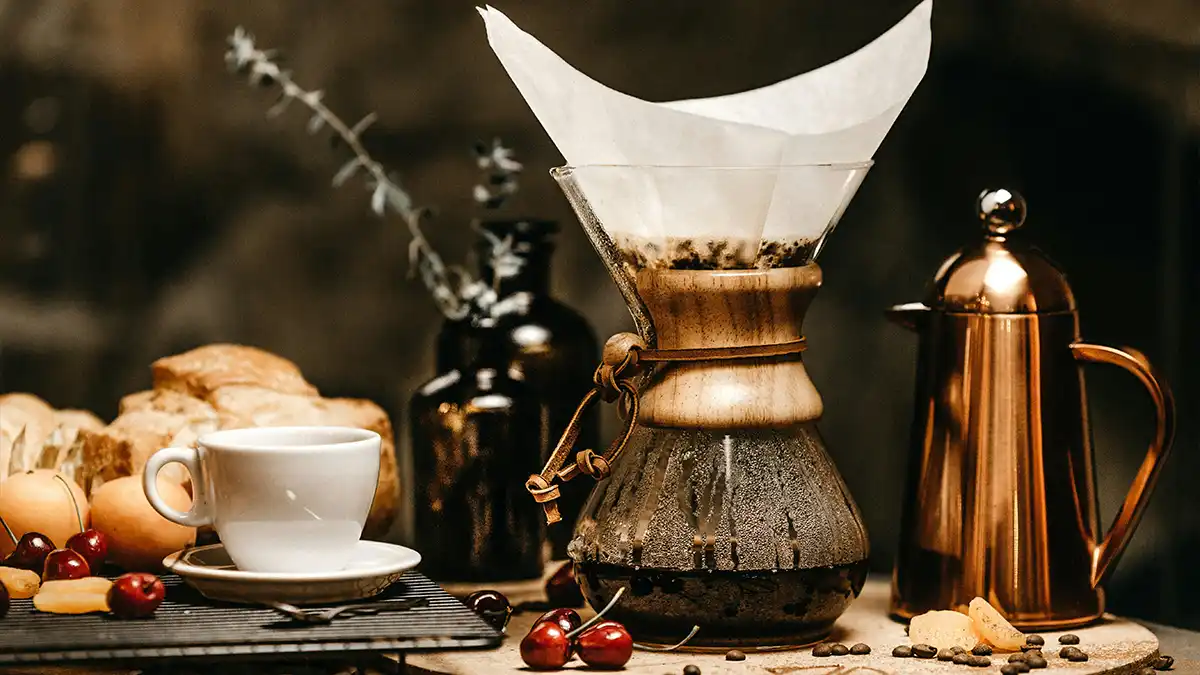How Many Cups of Coffee a Day Are Actually Good for You?
A Look At How Much Coffee Is A Healthy Amount And What Are The Health Benefits How Many Cups of…
This is a demo store for testing purposes — no orders shall be fulfilled. Dismiss
Skip to content
This article will guide you through what pour over coffee is and how it is made and enjoyed by coffee drinkers throughout the World.
Pour over coffee is more than just a method for brewing coffee; it is an art form that embodies precision, craftsmanship, and the pursuit of perfect flavour. This manual brewing technique has captured the hearts of coffee aficionados worldwide, thanks to its ability to unlock the full potential of coffee beans while offering a mindful and immersive brewing experience. In this detailed guide, we’ll explore the origins, science, techniques, and nuances of pour over coffee brewing, empowering you to craft your perfect cup.
The pour over coffee brewing method has its roots in early manual coffee-making techniques that date back centuries. Its modern iteration gained popularity in the 20th century with the invention of devices like the Chemex in 1941 by Dr. Peter Schlumbohm and the Melitta cone by Melitta Bentz in 1908. Both innovations were designed to improve the filtration process, allowing the coffee to shine without unwanted sediments or bitter flavours.
Today, pour over brewing is synonymous with specialty coffee culture. Devices like the Hario V60, Chemex, Kalita Wave, and Origami dripper each bring their unique design and functionality to the art of coffee preparation.
Unlike automatic coffee makers, pour over brewing provides unparalleled control over the variables that influence extraction, such as water temperature, grind size, and pouring technique. This control translates into a cup of coffee that reflects the care and attention invested in every stage of the brewing process.
Key benefits of pour over brewing include:
Pour over brewing relies on the principle of extraction—the process by which water dissolves coffee’s soluble compounds. The key is achieving balanced extraction, where the coffee’s acids, sugars, and bitter compounds are harmonized in the final brew. Here are the main factors influencing extraction:
Grind Size: A finer grind allows faster extraction, while a coarser grind slows it down. The optimal grind size for pour over is typically medium-fine, similar to granulated sugar.
Water Temperature: The ideal range is 90–96°C (195–205°F). Hotter water extracts flavours more quickly but risks over-extraction, whereas cooler water may result in a weak and under-extracted brew.
Brew Time: The total time for pour over brewing is usually 2.5–4 minutes, depending on the device and coffee-to-water ratio.
Agitation: Pouring water in controlled, spiralling motions helps evenly saturate the grounds, promoting even extraction.
Before you begin, gather the following tools:
Select high-quality coffee beans. Single-origin coffees, often grown at high altitudes and rich in unique flavour profiles, are especially well-suited for pour over brewing.
Grind your beans to a medium-fine consistency. Using a burr grinder ensures a consistent grind, which is crucial for even extraction.
Place the filter in your pour over device and rinse it with hot water. This step removes any papery taste and preheats the brewing vessel. Discard the rinse water.
Weigh your coffee beans and water to achieve the desired ratio. A common starting point is 1:16—1 gram of coffee for every 16 grams of water. Adjust the ratio based on your taste preferences.
Heat water to 90–96°C (195–205°F). Use a thermometer to maintain precise control. Temperature directly affects the extraction process.
Pour twice the weight of coffee in hot water (e.g., 50 grams of water for 25 grams of coffee) over the grounds. Allow the coffee to bloom for 30–45 seconds. The bloom releases trapped gases (primarily carbon dioxide) and prepares the grounds for even extraction.
Begin pouring in slow, steady spirals, starting in the centre and moving outward. Avoid pouring directly on the edges of the grounds. Add water in stages, maintaining a consistent flow rate. This technique ensures uniform saturation and extraction.
The entire brewing process should take approximately 2.5–4 minutes. Use a timer to track the duration and fine-tune for future brews.
Once brewing is complete, swirl the coffee to mix the flavours evenly. Pour it into your cup, inhale the aroma, and savour the fruits of your labour.
As you refine your pour over skills, explore advanced techniques to elevate your brewing:
The choice of pour over device influences the final cup:
Hario V60: Known for its conical shape and spiral ridges, the V60 enables rapid flow and nuanced flavour clarity.
Chemex: Featuring a thicker filter, the Chemex produces a clean and smooth brew with reduced oils and sediment.
Kalita Wave: Its flat-bottom design promotes even extraction, resulting in a balanced and full-bodied cup.
Each device brings a unique personality to your brew, encouraging experimentation and discovery.
Pour over coffee represents more than just a method; it is a philosophy that values mindfulness and intentionality. By immersing yourself in the brewing process, you gain a deeper appreciation for the craftsmanship that transforms coffee beans into a cherished beverage.
Pour over brewing invites you to slow down, reflect, and engage with your coffee on a profound level. It connects you to the farmers who cultivated the beans, the roasters who unlocked their potential, and the countless generations who perfected the art of coffee.
Pour over coffee is a celebration of precision and passion. It empowers coffee lovers to become artisans in their own right, crafting cups that reflect their individual tastes and dedication to quality. Whether you’re exploring new coffee origins, experimenting with brewing variables, or simply enjoying the tranquil beauty of the process, pour over brewing offers endless opportunities for discovery and delight.
So grab your kettle, your favourite beans, and your pour over device—and start creating coffee that’s not just a drink, but an experience worth savouring.
A Look At How Much Coffee Is A Healthy Amount And What Are The Health Benefits How Many Cups of…
How To Make The Perfect Espresso: A Comprehensive Guide for Home Baristas How To Make The Perfect Espresso Espresso is…
Tracing the Roots of Coffee: Where Does Coffee Come From? – Let’s Take A Journey through Time Where Does Coffee…

Signup for special offers & discounts
You have successfully joined our subscriber list.
coffee beans | ground coffee | coffee pods | coffee subscription | coffee gifts
signup and receive discounts!
Coffee Beans - Table of Contents
ToggleCoffee Beans - Table of Contents
×